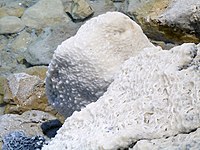
Photo from wikipedia
We characterized the mechanism underlying star anise (Illicium verum Hook.f) oil (SAO)–mediated antioxidant status during subclinical Escherichia coli (E. coli) challenge. A total of 512 male birds (White Leghorn) at… Click to show full abstract
We characterized the mechanism underlying star anise (Illicium verum Hook.f) oil (SAO)–mediated antioxidant status during subclinical Escherichia coli (E. coli) challenge. A total of 512 male birds (White Leghorn) at 30 wk of age with similar body weight (2.14 ± 0.02 kg) were randomly divided into 2 groups with 1 group being orally challenged with E. coli (every other day from day 15 to day 27) during the experiment. Each group of birds was then randomly allocated to dietary treatment of SAO supplementation at 0, 200, 400, or 600 mg/kg of basal diet (8 replicate cages during each treatment). The treatments were arranged a 4 × 2 factorial arrangement. The experiment comprised 1 wk of adaptation and 3 wks of data collection. There was no interaction (P > 0.05) between SAO supplementation and E. coli challenge for final body weight and average daily feed intake of birds. However, E. coli challenge resulted in a significant decrease (P < 0.001) in final body weight of birds as compared with unchallenged birds. There were interactions between SAO supplementation and E. coli challenge for the activity of glutathione peroxidase (GSH-Px) and malondialdehyde (MDA) concentration in serum and for the activity of GSH-Px in the liver of birds. Supplementation of SAO enhanced the activities of antioxidant enzymes but decreased the MDA content in the serum and liver of birds, and it also enhanced the expression of genes including superoxide dismutase, catalase, and nuclear factor E2–related factor 2 (Nrf2) in the liver of the birds. Meanwhile, supplementation of SAO can also reduce E. coli challenge–induced oxidative stress in the serum and liver of birds, and the efficacy of SAO in birds during subclinical E. coli challenge is dose-dependent. In conclusion, the enhancement of antioxidant capacity by star anise or its effective compounds is through upregulation of Nrf2 signaling pathway. The optimum supplementation dose of SAO for protecting birds against E. coli challenge is 400 mg/kg.
Journal Title: Poultry Science
Year Published: 2020
Link to full text (if available)
Share on Social Media: Sign Up to like & get
recommendations!